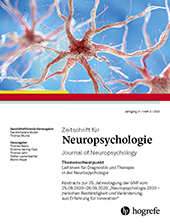Abstract
Zusammenfassung. Das Gesetz zur Reform der Psychotherapeutenausbildung bringt Veränderungen mit sich, die eine Neupositionierung der Klinischen Neuropsychologie im Rahmen der neuen Masterstudiengänge zur Vorbereitung auf das Staatsexamen Psychotherapie ermöglichen, aber auch erforderlich machen. Da künftig der Zugang zur Approbation und zur vertieften Ausbildung in Psychotherapieverfahren ausschließlich über den Klinischen Master möglich sein wird, ist es von essenzieller Bedeutung, auf eine klinisch-neuropsychologische Tätigkeit vorbereitende Inhalte so im Rahmen des Masterstudienganges zu verankern, dass der Nachwuchs für den Bereich der Klinischen Neuropsychologie entsprechend früh gewonnen wird. Der Artikel führt aus, wie wir dies in Zusammenarbeit mit den Lehrstühlen für Klinische Psychologie und Psychotherapie sowie für Klinische Kinder- und Jugendlichenpsychologie an der Ruhr-Universität Bochum erreichen möchten.
Abstract. The law to reform the training of psychological psychotherapists entails changes that require and enable a new definition of the role of clinical neuropsychology within the new master’s programs in preparation for the state approbation exam in psychological psychotherapy. In the future, access to the approbation and further training in psychological psychotherapy will be possible only after completing the master’s program in clinical psychology. It is thus essential to integrate clinical neuropsychology into the master’s program at an early stage and in a way that attracts students interested in working in clinical neuropsychology. This article reports on how we aim to achieve this in collaboration with the Clinical Psychology and Psychotherapy as well the Clinical Child and Adolescent Psychology units at the Ruhr University Bochum.
Literatur
Approbationsordnung für Psychotherapeutinnen und Psychotherapeuten (PsychThApprO) . Bundesgesetzblatt Jahrgang 2020, Teil I, Nr. 11, p. 448. Link: https://psychotherapie.dgps.de/filead min/user_upload/medien/ApprO_2020-03.pdf. Zuletzt aufgerufen am 01.07.2020.(2014). Mood disorders after TBI. Psychiatric Clinics of North America, 37, 13–29.
(1997). Der Bedarf an ambulanter neuropsychologischer Behandlung. Zeitschrift für Neuropsychologie, 8, 72–85.
(2010). Beschäftigung und berufliche Rehabilitation nach Schädel-Hirn-Trauma. Berlin: Springer.
(2009). Zur Versorgungssituation im Bereich der ambulanten neuropsychologischen Therapie – eine bundesweite Totalerhebung. Zeitschrift für Neuropsychologie, 20, 93–107.
(2014). Driving after traumatic brain injury: evaluation and rehabilitation interventions. Current Physical Medicine and Rehabilitation Reports, 2, 176–183.
(2018). Efficacy of telerehabilitation for adults with traumatic brain injury: A systematic review. Journal of Head Trauma Rehabilitation, 33, E33–E46.
(2020). Die berufsqualifizierende Tätigkeit im Studiengang klinische Psychologie und Psychotherapie. Verhaltenstherapie, 30, 170–177.



